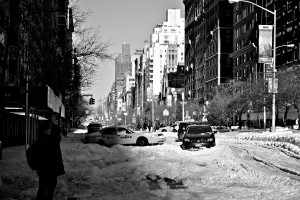After 20 years in graphic design, I’m back in school, studying to become a nurse. Even though nursing is a popular second career, people ask me all the time: “Why the 180?”
In December 2010, a blizzard dropped over 20 inches of snow on New York City. Unprepared, the city shut down. Buses lay jackknifed across intersections, wreaking havoc on those trying to clear the roads or respond to emergencies. Mayor Bloomberg implored all nonessential personnel to stay at home.

“Nonessential.”
The word stuck with me. A year and a half prior, I had been told by my employer that I was no longer needed as a graphic designer. With print design on its way out, and my technical skills quickly becoming obsolete, I found myself limited to periodic freelance work. As someone who highly values usefulness, I volunteered my services to various groups working toward social good, but it didn’t feel like enough. As important as it was to help nonprofits get quality messages out, it didn’t feel like world-changing work. It was still nonessential.
Enough.
I want to be essential personnel. I want to be the one who has to suit up during any state of emergency to give care and save lives. I want to do the work that “neither snow nor rain nor heat nor gloom of night” stays from appointed rounds. A career in nursing aligns with my personality and mission: I’m the one in any given group who remains calm in a crisis, who leads when no one else will, who finds no job beneath her in service to the good of the group. I believe creativity solves problems, and won’t give up until they’re solved. I want to know how things work, so that I can help improve them.
New York City has given me so much — as soon as I got here fifteen years ago, it felt like home — and I want to give back, by working in the public health system. I want to improve our community’s health and outreach capabilities, especially for the tired, poor, huddled masses who have been marginalized or shut out. I want to help all New Yorkers take care of themselves and each other, regardless of race, income, or background. I want to be there for people during the times when self-care and community are not enough, when they need extra help to survive — and to thrive.
This is an exciting time to enter the health care field. The implementation of the Affordable Care Act means millions more are now insured, regardless of previous health conditions or employment status, with protections for the LGBT community, parental coverage for adults under 26, and elimination of lifetime limits. The awareness of racial and class disparities and their effects on physical and emotional health is higher than ever before, thanks to the watchful eye of social media. Even New York is at the dawn of a new era, switching from a three-term millionaire mayor to a one with a diverse family and left-leaning politics.
I find these intersections of science, society, and spirit exciting. Being useful has always been important to me, but being useful while being relevant and humanist all at once used to be beyond my ambitions. Oh sure, learning dramatically new things as an adult is daunting. I joke about becoming ambicerebral rather than ambidextrous. But it turns out training a brain that recognizes typefaces to recognize signs and symptoms instead is not all that different. I bet that many of my skills and talents will be useful in the next two years of education, as well as in my new profession. I’m about to find out.



